Back to: home
Forward to: body plans
Anatomy terms
Scientific descriptions of Polydesmida are definitely not written in everyday language:
Epiproct digitiform, flattened dorsoventrally... in dorsal view subtruncate, slightly emarginate... Hypoproct semi-circular to subtriangular, more or less broadly rounded caudally...
On this website you can learn about body parts such as epiproct and hypoproct from their pictures (see the tail page), but it helps to know some more general words used by millipede specialists, as well. Some key anatomical terms and ideas about location and direction on a millipede's body are explained below.
For definitions of words used to describe shape and condition, go to the glossary page.
Anterior is towards the head, posterior is towards the tail. Medial is towards the midline of the body and lateral is towards the side of the body. Dorsal is towards the top of the millipede as it stands on its legs, and ventral is towards the bottom. Left and right are the millipede's left and right, not yours.
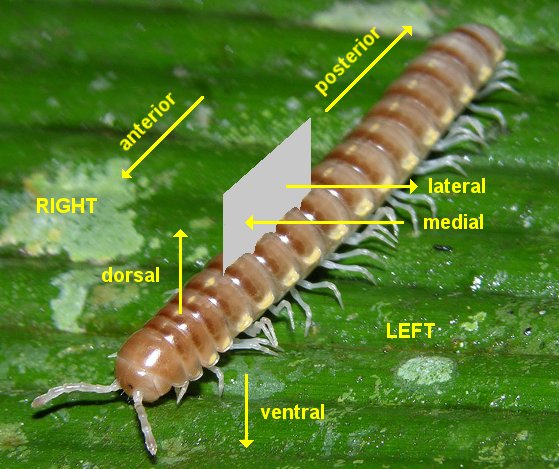
Unidentified polydesmidan, Ecuador
Base image © 2007 by Arthur Anker; used with permission
These direction words are used in a variety of ways. I might talk about the posterior surface of a particular part of a leg, by which I mean the surface closest to the tail of the millipede. I might say the millipede's body narrows posteriorly, which is shorter than saying the body gets narrower towards the tail.
There are a few often-used synonyms for these direction words. Caudal is interchangeable with posterior, mesal is the same as medial, and cephalically means anteriorly.
Anatomists put -ad at the end of a direction word to mean in the [ - ] direction. In many Polydesmida the dorsal surface is more darkly coloured than the ventral surface, so I might write colour lightening ventrad instead of colour lightening ventrally. Direction words with -ad are not used very often these days, but I have seen a few 21st-century scientific papers about millipedes with caudad, laterad, mesad, cephalad (towards the head) and orad (towards the mouth).
The appendages on the body (antennae and legs) have their own direction words: proximal, meaning towards the end which attaches to the body, and distal, meaning towards the free end, away from the body. These words apply to the whole appendage and also to each of its parts. |
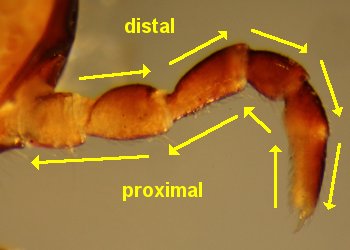 |
Basal (towards the base) and apical (towards the apex, or 'top') mean much the same as proximal and distal. However, basal and apical are usually reserved for descriptions of the gonopods and their parts, and for small structures such as setae. In the caption at right, 'distal surface' means the surface of the seta facing the distal end of the leg. |
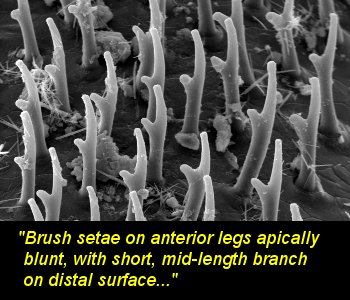 |
Direction words are often combined. A dorsal view looks at the top of a millipede, a lateral view is from the side, and a dorsolateral view looks at the millipede from an angle in between. |
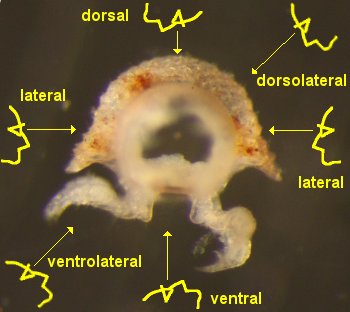 |
I like to illustrate gonopods with this view, which is right ventrolateral and slightly posterior. |
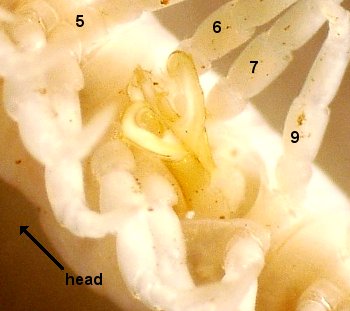 |
An axis which parallels the axis running from head to tail is called an anteroposterior axis, or more usually a longitudinal axis (L). Any axis running directly across a millipede's body is a transverse axis (T), and any top-to-bottom axis is a dorsoventral one (DV). |
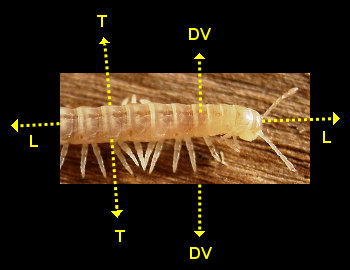 |
Finally, there is the curious word paramedian. It means close to the longitudinal midline of the body, but not actually on the midline. The species at right has a light-coloured paramedian spot (S) on either side of the midline on each metatergite. |
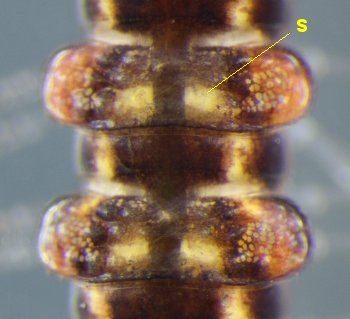 |
Back to: home
Forward to: body plans
